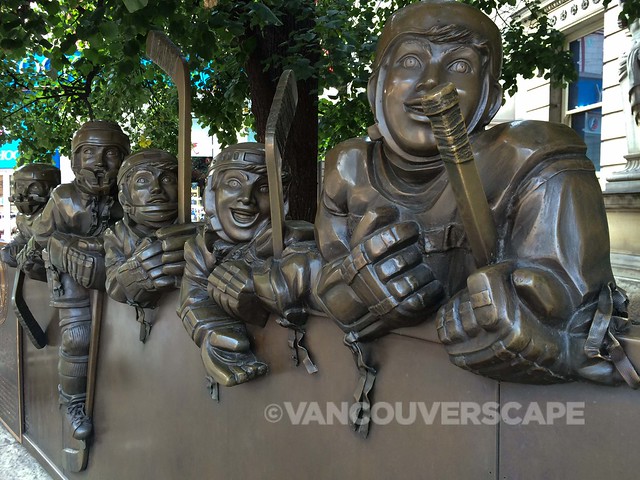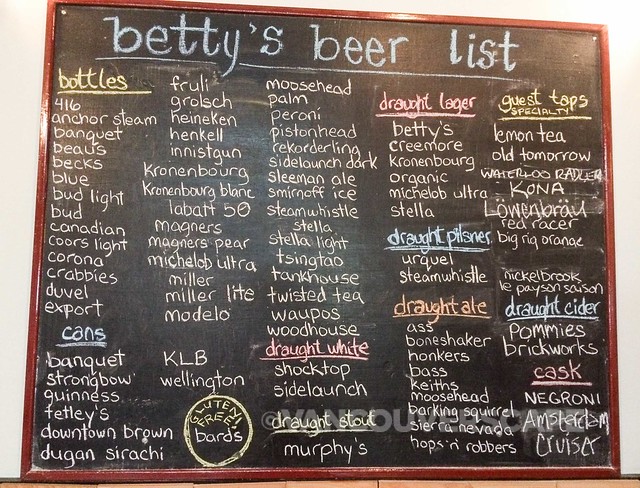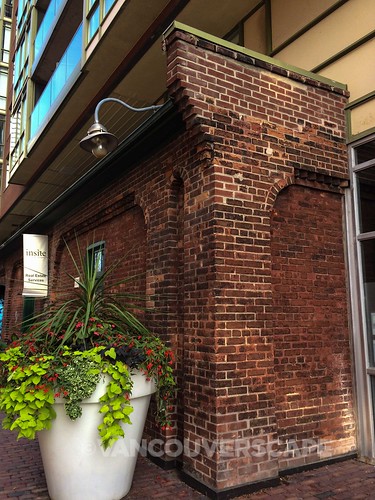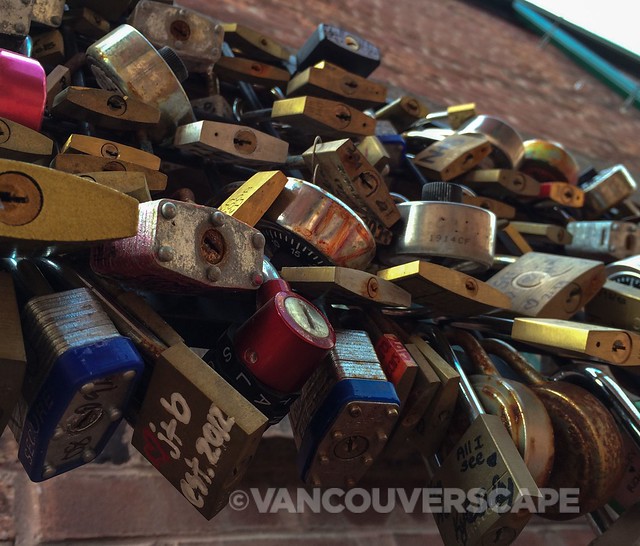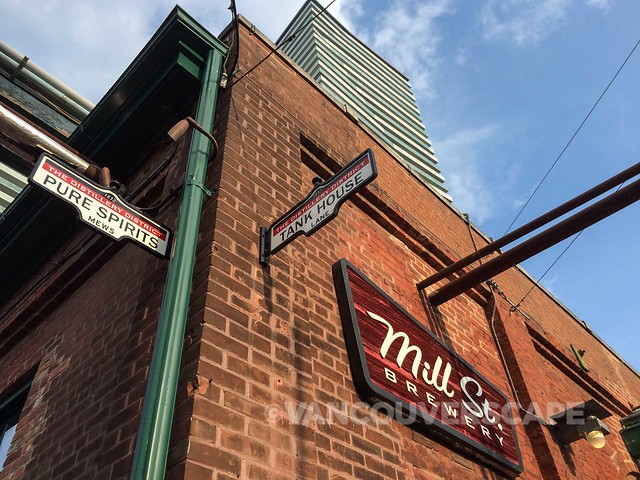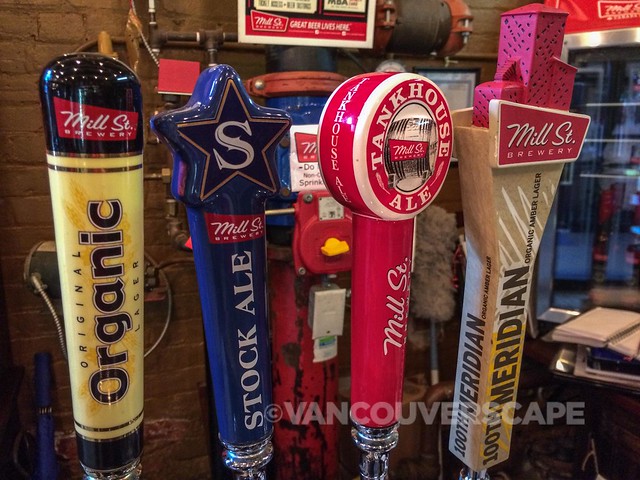I’m always up for a walking tour when arriving in a new city. When it’s combined with good craft beer, you’ve definitely got my attention. I recently joined Urban Adventures on a four-hour Beer Makes History Better tour.
Our meeting point is downtown at the Hockey Hall of Fame on Front and Yonge Streets, where tour guide Mike Carter starts off by explaining some of the city’s iconic buildings and hotels.
Before long, we’ve hit our first stop, C’est What?, a pub on Front and Church serving up 60 beers (about 47 of them on tap). The beer menu is pretty extensive and I decide on a County Durham Brewing Hop Addict IPA.
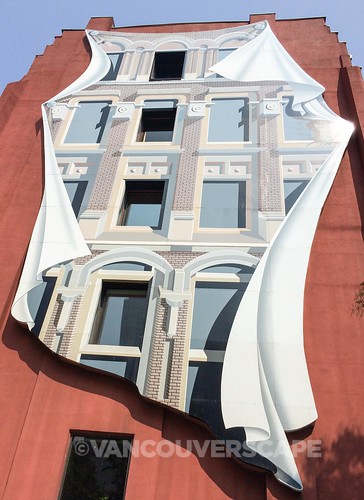

[L to R: Flatiron Mural, C’est What? entrance]
While we’re waiting on our beer, Mike gets a conversation started about cask ales, then brings up the Toronto craft beer movement which started in 1984 when Brick Brewery hit the scene, considered a crazy move at the time, going up against the long-standing big breweries.
Steam Whistle Brewing followed in 1999, then Mill Street in 2002 (read my Steam Whistle tour experience here). Toronto’s currently experiencing a craft beer boom much like Vancouver’s. With some of the strictest beer laws in Canada, buying brew wasn’t always easy.
Ontario was one of the unlucky provinces that experienced long-term prohibition. After Prohibition officially ended, the government created the Liquor Control Board of Ontario (LCBO), in order to strongly control the amount of liquor sold.
Folks would have to apply for a liquor permit, and were given a passport-style book along with their permit. When you wanted to buy liquor, here’s how it worked:
– You’d list your desired liquor (including beer, wine, spirits)
– Board alerted you to what was available on your list, adding your order to their copy of your list
– Your order got put into a brown paper bag to remain sealed until you arrived home
This style of booze shopping remained in effect until the early 1960’s.
Our second stop, Betty’s, is close to Brown College and attracts lots of students to its eclectic space. The bar began as Betty Ford’s however when the California-based Ford Clinic sent them a cease-and-desist letter, it was time to drop the Ford. What is it with Fords and Toronto?!
Here I sampled a Hop City Barking Squirrel Lager, before we moved on to The Distillery District, one of the city’s most unique pedestrian-only neighbourhoods, somewhat reminiscent of Yaletown due to its red brick buildings.
In the early 1830’s, James Worts and brother-in-law William Gooderham emigrated from England to Upper Canada to establish a flour milling business. Their 70-foot-tall windmill perched on the edge of Toronto Bay soon became a symbol of the new City of Toronto.
THE DISTILLERY DURING PROHIBITION
The distillery was allowed to operate during Prohibition because they’d ship product to other countries. In terms of beer, a rum runner would have a ship loaded with a hundred barrels of brew. Two hours later, the ship returned empty.
Customs officers knew the beer hadn’t left the province but as they weren’t paid very well, bribes were readily accepted. Rum runners also purchased liquor from Quebec, where Prohibition lasted a matter of days. The police eventually caught on to their game and put a stop to all illegal activity.
The Gooderham & Worts distillery closed in 1990, leaving behind hundreds of industrial artifacts. Free maps located close to the Mill Street entrance point out where to find them throughout the easily-walkable complex.
Unique architectural touches include balconies designed to impress businessmen and investors back in the day, decorative cupolas, chimneys, signage and corbelled brickwork. Shops, art galleries, bakeries, restaurants and segway rentals all find a home here. When in Toronto, make sure to visit this National Historic site with 40 Victorian buildings along with sculptures and heritage exhibits.
Mill Street Brewing has a commanding location (on Mill Street of course, where the brewery derives its name). They brew between 40 and 50 beers a year. In the small, well-stocked store, we sampled four of their more popular brands: Organic Lager, Stock Ale, Tank House Ale and 100th Meridian Amber Lager (my fave of the foursome).
Stock Ale uses a recipe similar to what would have been poured in the distillery’s heyday. While Tankhouse is an American style pale ale, 100th Meridian is the brewery’s answer to the craft beer craze. Their organic lager just happens to be Ontario’s first certified organic lager and is Mill Street’s signature brand.
By this time, I’d gotten a great overview of Toronto’s history through beer, politics and architecture. The tour costs $43 including tax. Beer is on your own dime for the first two stops and four taster samples are provided at Mill Street Brewery.
I was a guest of Urban Adventures’ Beer Makes History Better tour through Tourism Toronto. Opinions, as always, are my own.


